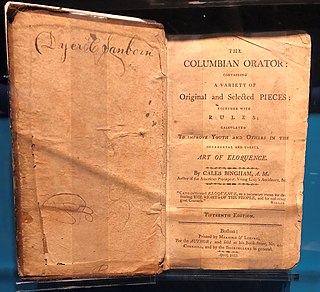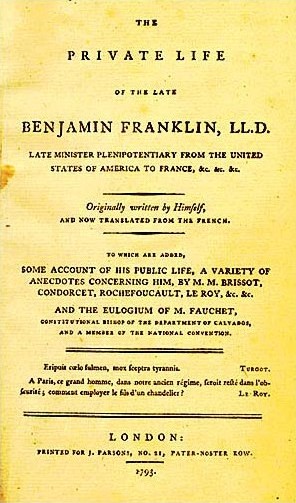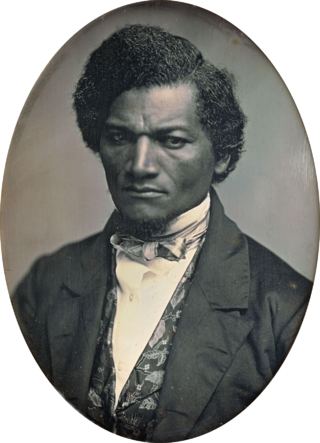
Benjamin Franklin was an American polymath, a leading writer, scientist, inventor, statesman, diplomat, printer, publisher, and political philosopher. Among the most influential intellectuals of his time, Franklin was one of the Founding Fathers of the United States; a drafter and signer of the Declaration of Independence; and the first postmaster general.

Frederick Douglass was an American social reformer, abolitionist, orator, writer, and statesman. He became the most important leader of the movement for African-American civil rights in the 19th century.
The slave narrative is a type of literary genre involving the (written) autobiographical accounts of enslaved persons, particularly Africans enslaved in the Americas, though many other examples exist. Over six thousand such narratives are estimated to exist; about 150 narratives were published as separate books or pamphlets. In the United States during the Great Depression (1930s), more than 2,300 additional oral histories on life during slavery were collected by writers sponsored and published by the Works Progress Administration, a New Deal program. Most of the 26 audio-recorded interviews are held by the Library of Congress.

Wage slavery is a term used to criticize exploitation of labor by business, by keeping wages low or stagnant in order to maximize profits. The situation of wage slavery can be loosely defined as a person's dependence on wages for their livelihood, especially when wages are low, treatment and conditions are poor, and there are few chances of upward mobility.

My Bondage and My Freedom is an autobiographical slave narrative written by Frederick Douglass and published in 1855. It is the second of three autobiographies written by Douglass, and is mainly an expansion of his first, Narrative of the Life of Frederick Douglass, an American Slave. The book depicts in greater detail his transition from bondage to liberty. Following this liberation, Douglass went on to become a prominent abolitionist, speaker, author, and advocate for women's rights.

Incidents in the Life of a Slave Girl, written by herself is an autobiography by Harriet Jacobs, a mother and fugitive slave, published in 1861 by L. Maria Child, who edited the book for its author. Jacobs used the pseudonym Linda Brent. The book documents Jacobs's life as a slave and how she gained freedom for herself and for her children. Jacobs contributed to the genre of slave narrative by using the techniques of sentimental novels "to address race and gender issues." She explores the struggles and sexual abuse that female slaves faced as well as their efforts to practice motherhood and protect their children when their children might be sold away.

Narrative of the Life of Frederick Douglass is an 1845 memoir and treatise on abolition written by African-American orator and former slave Frederick Douglass during his time in Lynn, Massachusetts. It is generally held to be the most famous of a number of narratives written by former slaves during the same period. In factual detail, the text describes the events of his life and is considered to be one of the most influential pieces of literature to fuel the abolitionist movement of the early 19th century in the United States.
The American Renaissance period in American literature ran from about 1830 to around the Civil War. A central term in American studies, the American Renaissance was for a while considered synonymous with American Romanticism and was closely associated with Transcendentalism.
African American literature is the body of literature produced in the United States by writers of African descent. It begins with the works of such late 18th-century writers as Phillis Wheatley. Before the high point of enslaved people narratives, African American literature was dominated by autobiographical spiritual narratives. The genre known as slave narratives in the 19th century were accounts by people who had generally escaped from slavery, about their journeys to freedom and ways they claimed their lives. The Harlem Renaissance of the 1920s was a great period of flowering in literature and the arts, influenced both by writers who came North in the Great Migration and those who were immigrants from Jamaica and other Caribbean islands. African American writers have been recognized by the highest awards, including the Nobel Prize given to Toni Morrison in 1993. Among the themes and issues explored in this literature are the role of African Americans within the larger American society, African American culture, racism, slavery, and social equality. African-American writing has tended to incorporate oral forms, such as spirituals, sermons, gospel music, blues, or rap.

The Columbian Orator is a collection of political essays, poems, and dialogues collected and written by Caleb Bingham. Published in 1797, it includes speeches by George Washington, Benjamin Franklin, and some imagined speeches by historical figures such as Socrates and Cato. It was popularly used for recitation in American schoolrooms from 1790 to 1820 to teach pupils reading and speaking. Typical of many readers of that period, the anthology celebrated "republican virtues," promoting patriotism and questioning the ethics of slavery. The Columbian Orator is an example of progymnasmata, containing examples for students to copy and imitate.

The Autobiography of Benjamin Franklin is the traditional name for the unfinished record of his own life written by Benjamin Franklin from 1771 to 1790; however, Franklin appears to have called the work his Memoirs. Although it had a tortuous publication history after Franklin's death, this work has become one of the most famous and influential examples of an autobiography ever written.

Deborah Read Franklin was the common-law wife of Benjamin Franklin, polymath and one of the Founding Fathers of the United States.

Ottilie Davida Assing was a 19th-century German-American feminist, freethinker, and abolitionist.

The Heroic Slave, a Heartwarming Narrative of the Adventures of Madison Washington, in Pursuit of Liberty is a short piece of fiction, or novella, written by abolitionist Frederick Douglass, at the time a fugitive slave based in Boston. When the Rochester Ladies' Anti Slavery Society asked Douglass for a short story to go in their collection, Autographs for Freedom, Douglass responded with The Heroic Slave. The novella, published in 1852 by John P. Jewett and Company, was Douglass's first and only published work of fiction.

Life and Times of Frederick Douglass is Frederick Douglass's third autobiography, published in 1881, revised in 1892. Because of the emancipation of American slaves during and following the American Civil War, Douglass gave more details about his life as a slave and his escape from slavery in this volume than he could in his two previous autobiographies. It is the only one of Douglass's autobiographies to discuss his life during and after the Civil War, including his encounters with American presidents such as Lincoln and Garfield, his account of the ill-fated "Freedman's Bank", and his service as the United States Marshall of the District of Columbia. Frederick Douglass shed light on what life was like as an enslaved person. Although it is the least studied and analyzed, Life and Times of Frederick Douglass allows readers to view his life as a whole.
Thomas Denham was a Philadelphia merchant who plays an important role in The Autobiography of Benjamin Franklin, as a father figure, friend, and benefactor who helps the young Benjamin Franklin during and after his first trip to England in 1724–1726. Upon their return to the Colonies in 1726, Denham employs Franklin as a clerk and bookkeeper in his newly opened shop, which was likely located at the current day address of 39 South Front Street, Philadelphia, Pennsylvania.
A self-made man, is a person whose success is of their own making. In the intellectual and cultural history of the United States.

"What to the Slave Is the Fourth of July?" was a speech delivered by Frederick Douglass on July 5, 1852, at Corinthian Hall in Rochester, New York, at a meeting organized by the Rochester Ladies' Anti-Slavery Society. In the address, Douglass states that positive statements about perceived American values, such as liberty, citizenship, and freedom, were an offense to the enslaved population of the United States because they lacked those rights. Douglass referred not only to the captivity of enslaved people, but to the merciless exploitation and the cruelty and torture that slaves were subjected to in the United States.
William Grimes was an African American barber and writer who authored what is considered the first narrative of a formerly enslaved American, Life of William Grimes, the Runaway Slave, published in 1825, with a second edition published in 1855. Another revised edition was published by one of his descendants in 2008. Grimes escaped slavery by boarding on a ship called Casket, which sailed from Savannah, Georgia to New York City. He then walked to Connecticut from New York City to begin his life as a free man. Grimes lived in Stratford, Norwalk, Fairfield, Bridgeport and Stratford Point alongside New Haven and Litchfield, Connecticut following his escape from slavery. New Haven was where Grimes eventually settled to live out his final days.

The Busy-Body was a pen name used by Benjamin Franklin and Joseph Breintnall in a column printed in The American Weekly Mercury, an early American newspaper founded and published by Andrew Bradford. There are 32 letters in "The Busy-Body" series. The essays were printed in 1729.














